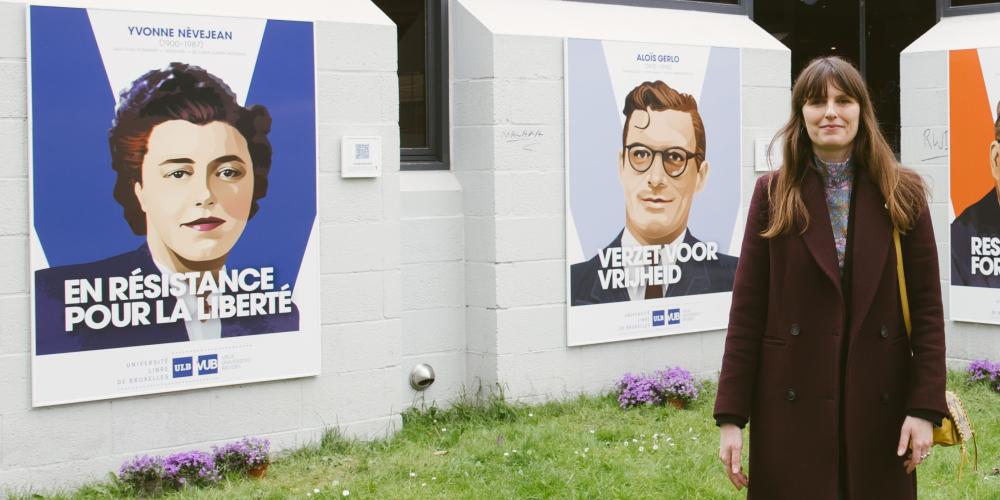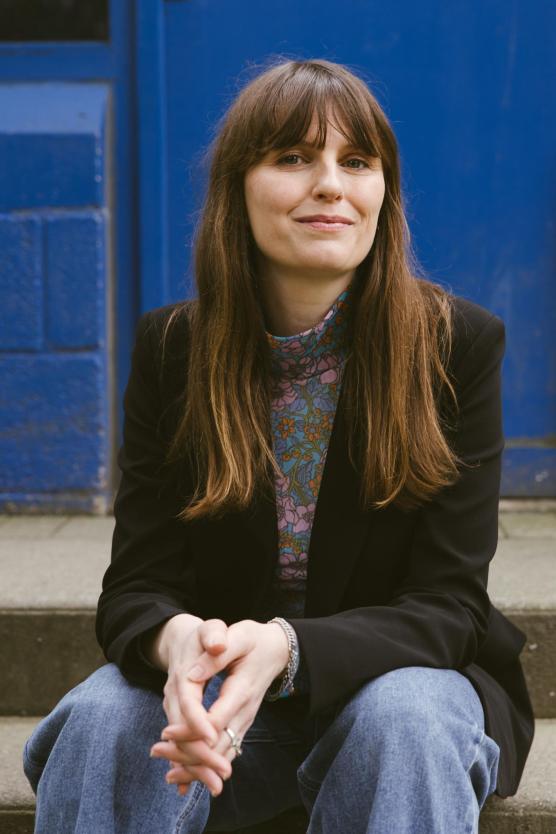
In collaboration with the Heroes of the Resistance association, the VUB has established the chair ‘Traces of the Resistance’. Led by Professor of Contemporary History Nel De Mûelenaere and Dany Neudt from the association, the chair will coordinate four years of research into the Belgian resistance during World War II and share this knowledge with the public. On 8 May, a resistance trail was opened on the Etterbeek campus to commemorate Belgian resistance fighters, featuring portraits of resistance members.
Would you like to support the research under the Chair of Traces of Resistance? You can do so
Why establish this chair?
Nel De Mûelenaere: “In recent years, there has been a certain catch-up movement in Belgium, especially in Flanders, regarding resistance history. In neighbouring countries, this was never necessary; there was always attention for the resistance against Nazism, partly due to a pronounced national remembrance policy around resistance figures. In France, everyone knows Jean Moulin, in the Netherlands, Hannie Schaft. We also had remarkable resistance fighters in Belgium, but they hardly featured in public memory. In recent years, historians like Koen Aerts and Nico Wouters have generated more attention for the history of the resistance. With the VRT series ‘Children of the Resistance’, the book ‘Was Grandpa a Hero’, and now the historical ‘Here and Then’ episode about the Comet escape network. As a result, remembrance initiatives like the 8 May Coalition and the Heroes of the Resistance association emerged. The latter posts a photo of a resistance member on social media every day. This attention is finally breaking the silence and some negative myths surrounding the resistance.”
"More than 140 professors and students of the ULB died as political prisoners."
"The VUB has a historical affinity with the history of the resistance. Many professors and students from the ULB (the VUB originated from the ULB in 1970, ed.) joined the resistance and paid a high price: more than 140 died as political prisoners. The ULB also decided, uniquely among Belgian universities, to close its doors during the war on 25 November 1941."

What exactly will the chair entail?
"It consists of two parts: we initiate research projects, apply for funding, and organise scientific lectures. The second part, coordinated by Dany Neudt, is more public-historical; it will involve the general public in the research. For instance, we are starting a heritage and research project on the farewell letters of executed resistance members. Some were collected by Cegesoma (Centre for Historical Research and Documentation on War and Contemporary Society), and we suspect there are more at people's homes since those letters were sent to the relatives. We will launch calls to find new ones. In a second phase, we want to digitise, transcribe, and translate the handwritten letters. This will enable further research into execution procedures as part of German repression and text analysis of the letters."
How can students participate?
"As a history lecturer, I will supervise bachelor papers and master's theses on resistance history in the coming years. This way, I hope to inspire some students to conduct further research, for instance, on specific networks or resistance activities in a municipality."
"It is not our intention to create new myths. We are not interested in writing hagiographies about the Belgian resistance."
Do you think the current generation of students knows much about the history of the resistance?
"There is a great interest because this history is inspiring, but also because it is multifaceted. There are many contradictions in the history. There is the predominantly negative myth-making about the resistance, mainly created by the Flemish collaboration environment. When Belgium was largely liberated in September 1944, many resistance fighters were still in camps. Moreover, the resistance was a very pluralistic movement that did not have the unity after the war to convert victory into political and social capital. As a result, resistance fighters could be portrayed as opportunists, either as so-called ‘September resistors’ – people who joined the resistance only when the Nazis' chances of winning turned – or as criminals who disregarded civilian casualties. This negative image is inaccurate. There were also very conservative resistance members, people from the nobility, royalists, artists, liberals, socialists, Catholics, and clergy involved. They participated in a wide range of resistance activities for various reasons – from anti-fascism to royalism, as well as humanitarian or material reasons. Despite their significant differences, some worked particularly well together during the war. When the common enemy disappeared, internal contradictions emerged, and they split into ideological camps, unable to provide a strong response to the negative image."
"But the chair does not aim to create new myths. We are not interested in writing hagiographies about the Belgian resistance. Frankly, I find the humanity they showed, their contradictions, and internal struggles just as fascinating."
Are there still stories that need to be uncovered?
"There is much work to be done. The resistance has often been studied from an organisational perspective, but it is certainly worthwhile to look at specific individuals and the networks in which they operated, as well as the complex reasons why certain people joined the resistance. There is also a lot of research to be done on symbolic, passive resistance and its impact. Additionally, we need to study how to measure the efficiency and effectiveness of armed resistance actions from a military perspective. We also want to collaborate with other universities, across the language border, to launch innovative research. The history of the resistance is, after all, a Belgian history."
"Resistance members often showed deep solidarity with complete strangers. And that is something we can only admire."
Where does your personal fascination for this history come from?
"I grew up in West Flanders, in Ardooie, with the images of the war cemeteries from WWI. As a child, I would calculate the ages of the fallen soldiers at the graves and look up the stories behind those names with my father. My great-grandfather fought at the Yser, and when his youngest child was born, WWII broke out. The world wars completely shaped and coloured the lives of our great-grandparents and grandparents. I hope to contribute a small part to the historical understanding of this."
I assume you have seen the film Wil. In your opinion, does it provide a nuanced view of the resistance and collaboration?
"I think the film effectively captures the fear and complexity of that period. It shows that people can make completely contradictory decisions and that we need to think in shades of grey. But we must not overly nuance the resistance: we can still be inspired by those resistance fighters and the choices they made to stand up against a particularly repressive foreign occupier, at great personal risk. They often showed deep solidarity with complete strangers. And that is something we can only admire."
The world needs you
This initiative is part of VUB's public programme, a programme for everyone who believes that scientific knowledge, critical thinking and dialogue are an important first step to create impact in the world.
As an Urban Engaged University, VUB aims to be a driver of change in the world. With our academic edcuational programmes and innovative research, we contribute to the Sustainable Development Goals of the United Nations and to making a difference locally and globally.